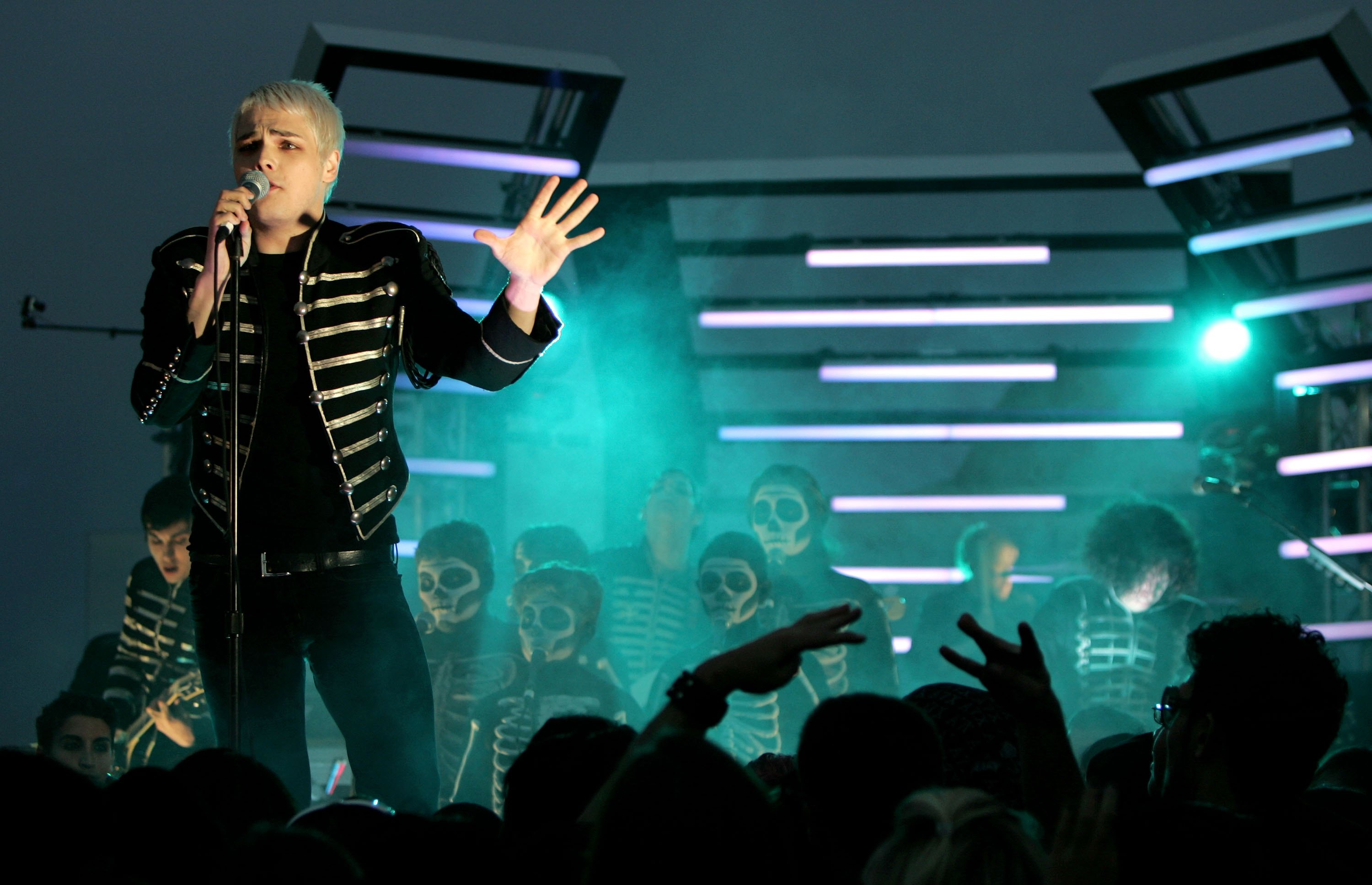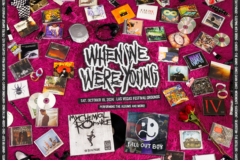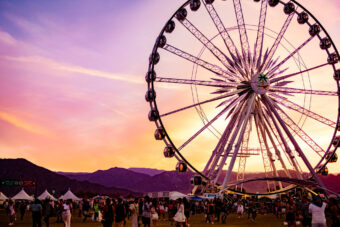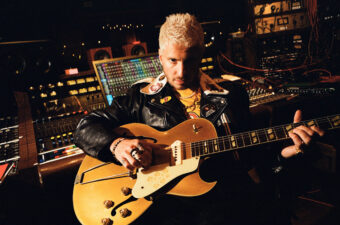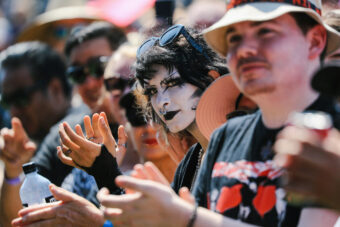The definition of emo depends on who you’re talking to. Kids who came of age in the early-to-mid aughts knew “emo” as a catch-all slang for hook-heavy, vocally pinched, overly emotive, pop-punk-ish guitar bands like Fall Out Boy, Hawthorne Heights, Panic! At the Disco, and every other group of moody, occasionally pasty youths who might have graced the cover of Alternative Press. Some of them wore makeup and all black; some of them didn’t. Some of them had a sense of humor about their aesthetic; some of them really didn’t. Within the emo scene, their forefathers were high stakes, high-voiced bands like Taking Back Sunday, Thursday, and Saves the Day, rather than the knottier, more elliptical bands like American Football or Sunny Day Real Estate. A more pedantic analyst would call it something like “third-wave mall-punk.”
Outwardly, this brand of emo seemed like just another sect of bands that took advantage of the emotional narcissism of teenagers and, more importantly, that they didn’t know how to sit down and sort it out. (In terms of radio airplay, their immediate antecedents were bands like Weezer, blink-182, and Green Day.) Still, they ramped up the introspective angst of their predecessors by a notch; like Romeo and Juliet, they saw love as a raging turmoil that might only find resolution in the afterlife. A histrionic line like Taking Back Sunday’s “If you could slit my throat / With my one last gasping breath, I’d apologize for bleeding on your shirt” characterized the emotional urgency that filled every song about how some crush wasn’t working out. The stakes were all or nothing.
My Chemical Romance slotted naturally into this scene, even if they blanched at the phrase “emo.” Their origins were something out of a superhero movie: They were founded by Gerard Way in the weeks following the September 11 attacks, which he observed firsthand while working in downtown New York. “Something just clicked in my head that morning,” he told SPIN in a 2005 cover story. “I literally said to myself, ‘I’ve gotta get out of the basement.’” Shortly after the attacks, he recruited the band’s members in their native New Jersey, where they practiced every day with a view of the newly-changed New York skyline. (“It was like a therapy for all of us,” he said in a 2004 MTV interview.)
After releasing their debut record in 2002, they came to attention with 2004’s Three Cheers for Sweet Revenge, which sounded like Heathers turned into a musical. They were restless, mordant goths brimming with feelings about dating and death, yelling over pop-inflected punk songs filled out with big, melodic guitar leads indebted to bands like Queen and Led Zeppelin, setting them apart from the distorted dynamics of their emo peers. Their videos were over-the-top and engaging—“Helena” staged a funeral thrown by Tim Burton, complete with dance sequence—but definitely self-aware, like the Wes Anderson-parodying mini-film for “I’m Not Okay.”
The record was a modest but clear success, going platinum within a year, placing their videos on MTV, and winning them profiles in national magazines. For their follow-up, they decided to get bigger. The band was working with Rob Cavallo, the superstar producer with experience in cleaning up smaller scene stalwarts like Green Day and Jawbreaker. In a 2010 SPIN interview, guitarist Ray Toro called Cavallo a “master” at removing a band’s preconceived limits. He was the perfect person to helm their transition from bratty insurgents to blockbuster headliners.
[featuredStoryParallax id=”213374″ thumb=”https://static.spin.com/files/2016/10/MCR2_GettyImages-114789089-1477336772-300×201.jpg”]
Likewise, Way was the perfect vessel for such dramatic ambitions. A lifelong comic book fan, he wrote lyrics that melded monologues about intimate feelings with cartoonish imagery of devils and blood drinkers into campy but earnest narratives—pomp intermixed with circumstance. “Wipe off that makeup, what’s in is despair,” he snarled on the opening song, “The End.” By standards of adult sophistication, his writing might’ve been too outlandish not to prompt an eye roll, but he chewed each word like a stage actor giving the performance of his life. His emotive face, drawn with sharp cheekbones and weeping eyes, drove fans to empathize with his demons.
And so The Black Parade—which celebrated its 10th anniversary on Sunday—blew out their preening, death-obsessed ethos into proper stadium rock. The band loosened their pants and donned monochrome military jackets like Sgt. Pepper’s styled by Hot Topic. They came up with a storyline about the Patient, a cancer victim who dies and then revisits the events of his life—the parades he visited as a child, the wars he fought and the loves he lost as an adult. In an awesomely pretentious rock star move, Way decided to buzz and bleach his hair, in order to better vibe with the cancer-afflicted main character.
Way was a carnival barker in front of the twin-guitar attack of Ray Toro and Frank Iero, who provided the band’s instrumental thrust. Iero drove the tracks with relentless punk energy, while Toro’s instincts trended toward the scaled-up dinosaur rock of his youth. “If you isolate the guitar tracks, you can hear them smashing into each other,” Cavallo said to the Alternative Press. The tension was exemplified on songs like “Dead!,” in which a jagged, start-stop riff was counterbalanced by a series of swaggering, pyrotechnic solos, and “This Is How I Disappear,” which sounded like mallrats covering Black Album Metallica.
These were operatic songs about grappling with despair and death and loneliness—Threepenny Opera for LiveJournal users, radical teenage angst performed by a pissed-off symphony. There were big, dumb “rock opera” excesses: They got Liza Minnelli—canonized in a 2006 SPIN review as Liza fucking Minnelli—to vamp it up on “Mama,” and opened the harrowing “Sleep” with a scratchy recording of Way recounting a night terror. They reinterpreted the weepy, glammy power ballad for the emo circuit, like on “I Don’t Love You” and “Disenchanted.”
“Teenagers” was a radio-ready crystallization of the “us vs. them” conflict at the heart of all youth music. Way inhabited an angry youth as he sang about the secret fear at the heart of all cable news reports: that the kids, fueled by hormones and video games, are ready to cut the shit and shoot us all down. The riff was cleaner and simpler than anything else on the record, giving Way the space to chant his lyrics, resonant in a post-Columbine world still absorbed with the idea that all trouble and hurt malcontents were ticking time bombs.
The album’s first single was “Welcome to the Black Parade,” the Patient’s origin story. It was a masterful construction of parts cobbled from rock history: a singer-songwriter, piano-driven dirge; a driving pop-punk exorcism; a colossal outro layered with ascending vocals where Gerard Way wailed about learning to deal with loss. Forgive the word, but it was genuinely epic, a “Bohemian Rhapsody” for millennials. The video, which showed the band as gothic grand marshals for a parade marching down some ghoulish main street, gave them authority and presence. They were no longer coming up from the underground; they were leading the charge. It peaked at #9 on the Billboard charts, right behind Justin Timberlake’s “My Love,” becoming the band’s largest hit.
The emo milieu produced plenty of great records, but The Black Parade towered over them in surface ambition. My Chemical Romance, with their outsized musical approach and their meticulously costumed aesthetic, were maybe the best contemporary band at weaving a costume out of feelings ripped right from the heart. There was a cross-generational component, too, as the band was updating the performative rock n’ roll tradition for modern times. Bowie did it; why couldn’t millennials?
[featuredStoryParallax id=”213375″ thumb=”https://static.spin.com/files/2016/10/MCR3_GettyImages-110290137-1477336864-300×222.jpg”]
Anniversary pieces are strange in that they largely reaffirm greatness that was consensus at the time of an album’s release; the critical stance on a Nevermind or Revolver hasn’t changed in the years since. But The Black Parade, though well-reviewed at the time, hasn’t accrued the same reputation as other classic albums. It was almost entirely ignored in lists of the best albums of the ‘00s run by tastemakers and canon formers like Rolling Stone, Pitchfork, Stereogum, Billboard, Paste, Complex, NME, and, yes, SPIN.
As far as painted-up musicians went, My Chemical Romance were too ironic and sexless to be KISS, too uncool and sexless to be Bowie. They were lumped in with the stereotyped emo package—these guys with their eyeliner and tight pants and amateurishly trimmed swooshy haircuts, howling in high voices about how their hearts hurt, all of which was easily brushed off as affectation. Bleeding heart melodrama did not go with the dry wit of indie rock, nor did their carefully contoured fashion sense. My Chemical Romance may have reached for earnest, anthemic highs as a band like the Arcade Fire, but they didn’t code as the same authentic experience for indie culture.
And yet they were legitimately massive, the last movement of weird-ish guitar-driven bands to reach the millions of young outsiders and oddballs waiting for something to grab them by the throat—and The Black Parade was their apotheosis. This isn’t meaningless, either, given that there’s always something to be taken from studying the aggregated cultural tastes of millions—especially young people, who set the cultural tone and dare adults to catch up. In a different era, they might never have ascended to such mainstream heights. My Chemical Romance and their peers came around at a time when youth culture’s inner monologue was, for the first time, given a public stage to present itself. Their fans were the first generation of teens whose diaries played out via social media platforms—MySpace, LiveJournal, O.G. Facebook—on platforms built specifically to snapshot their messy feelings for everyone else to see.
These kids were breaking ground in a way, by being the face of chronicling feelings that’d never been so bluntly and openly performed, often without nuance. The lonely process of appending a “feeling sad” status to your LiveJournal, and waiting for a friend to comment; the emotional debate of revamping one’s top friends on Myspace; the secret thrill of reading the personal blog of a high school crush. Teenagers had always wanted to connect, and to feel, but those urges were now intersecting in a way that felt new and weird. Consciously or not, emo bands captured the moods of this transitional moment in ways that invariably coded as populism, thanks to their love of catchy sounds and refusal to be cowed for their emotions.
Every so often, there’s a meandering “Is Rock Dead?” think piece that pops up here and there. As a literal argument, it’s obviously not true. There are dozens and dozens of new bands starting up right now, playing music for thousands of fans who ultimately don’t care too much about chart performance or Metacritic averages. Neil Young never told a lie; rock n’ roll will never die, inasmuch as rebellion and heartbreak are inexhaustible resources, and will always manifest themselves in noisy songs banged out by those attracted to the possibility of mastering the guitar, or just look good holding one.
Even so, rock n’ roll as dominant musical praxis has been on the wane since at least the Bush Jr. years, and with good reason: The myths of rock n’ roll, historically a genre dominated by white men, are less valorized by a pan-ethnic, pan-gender aesthetic electorate exploring more modern ideas through pop, R&B, rap, electronic, and many other sounds. (Guitars are also expensive.) But there’s value in remembering what rock n’ roll provided, and continues to provide for young people still figuring it out. Surrounded by the noise, the sturm und drang of wailing guitars and thundering drums, you’re more empowered to scream—and in the noise, feel a kinship with others like you.
[featuredStoryParallax id=”213377″ thumb=”https://static.spin.com/files/2016/10/MCR4_GettyImages-121052054-1477337132-300×209.jpg”]
A decade removed from The Black Parade, the band members were ready to let the record, which was reissued as a deluxe edition in September, speak for itself. But I did manage to get in touch with Ray Toro, who in 2016 is no longer a mall-punk but a father, and a musician who continues to play for himself and for others. As he tells it, the band was blown away by the overwhelming reply to a July 20 video teasing the reissue, which was widely interpreted as announcing their reunion. (They quickly doused the rumors a day later.)
“I don’t really know if any of us were ever really aware of how popular the record actually was,” he said. “I saw the trailer for the re-release, and we started seeing stories from all over the place talking about the band. They started following up to talk more about the record, and that’s all an artist dreams of.”
He went on. “You put music out into the world and you’re sharing a piece of yourself, especially for certain types of musicians where we’re socially awkward, unpopular weird people, but when you get on stage with your guitar or in the studio you express yourself the way you can’t with people. So it’s very personal—a record, or anybody’s art. It’s extremely personal. To see that so many people connected to it—it’s the best case for putting something out into the world like that.”
I connected with My Chemical Romance at the time, though I was bashful about it because I felt odd admitting these grease-painted performers spoke to me. Ten years later, it’s easier to accept a former self that was awkward and weird, and figuring it out—to draw on it in remembering what comes next. And when I listen to The Black Parade today, and think about this inchoate identity far removed from adulthood, I hear a connection beyond the death and despair—a recognition that through this sloppy process of sorting oneself both publicly and privately might come a kind of maturation.
It’s there when Gerard Way sings as an adult on “Teenagers,” worried about the homicidal ideation that rises from isolation, because he once felt that way, and understands there’s a way beyond. It’s there when he sings “we’ll carry on” in the title track not as a promise, but as a mantra. It’s in “I Don’t Love You,” a melancholy kiss-off to one’s formerly tumultuous feelings. It’s in the waterfall of pathos in album closer “Famous Last Words,” which Toro names as his favorite.
“The whole record is really about redemption and kind of picking yourself up no matter what and continuing to live and move on,” he told me. That feeling is resonant in the video for “Famous Last Words,” when the band plays in their Black Parade costume, backed by nothing but spewing flames against a dark sky. Toro’s guitar-playing is triumphant and euphonious. Way drops to his knees as he sings and screams, because he’d actually torn his muscles as he fell—another blurring of the lines between real and performed pain. It ends with Way, unadorned, singing into the void for the kids: “I am not afraid to keep on living / I am not afraid to walk this world alone.”

